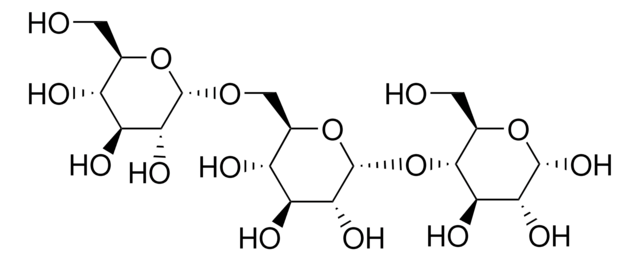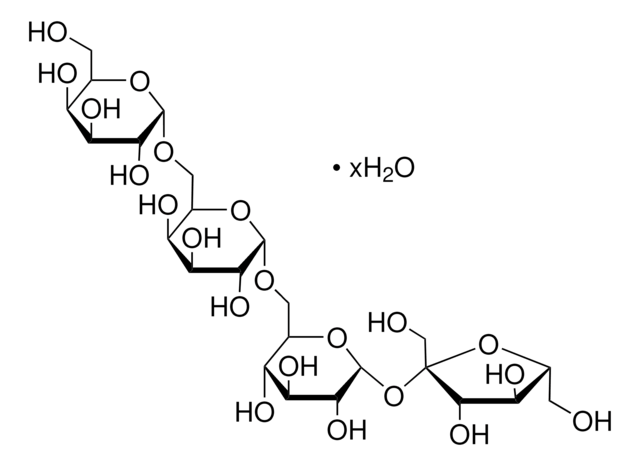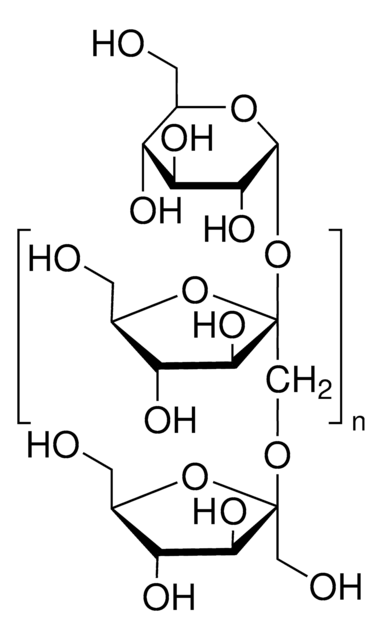推荐产品
生物源
plant
品質等級
化驗
≥94% (HPLC)
形狀
powder
光學活性
[α]20/D 108.5 to 112.0 °, c = 0.84% (w/v) in water
儲存條件
desiccated
雜質
≤12.5% water (Karl Fischer)
顏色
white to off-white
溶解度
H2O: 50 mg/mL, clear to slightly hazy, colorless to faintly yellow
儲存溫度
−20°C
SMILES 字串
OC[C@H]1O[C@H](O[C@H]2[C@H](O)[C@@H](O)[C@H](O[C@@H]2CO)O[C@]3(CO)O[C@H](CO)[C@@H](O)[C@@H]3O)[C@H](O)[C@@H](O)[C@@H]1O
InChI
1S/C18H32O16/c19-1-5-8(23)10(25)12(27)16(30-5)32-14-7(3-21)31-17(13(28)11(14)26)34-18(4-22)15(29)9(24)6(2-20)33-18/h5-17,19-29H,1-4H2/t5-,6-,7-,8-,9-,10+,11-,12-,13-,14-,15+,16-,17-,18+/m1/s1
InChI 密鑰
FVVCFHXLWDDRHG-KKNDGLDKSA-N
應用
Erlose, a triose sugar (trisaccharide), is used in studies on dietary preference and utilization of triose sugars from aphid honeydew by various insects, such as honey bees and ants. Erlose may be used as a reference compound in assays that analyze the sugars of foods such as royal jelly and honey.
注意
moisture sensitive
其他說明
To gain a comprehensive understanding of our extensive range of Oligosaccharides for your research, we encourage you to visit our Carbohydrates Category page.
儲存類別代碼
11 - Combustible Solids
水污染物質分類(WGK)
WGK 3
閃點(°F)
Not applicable
閃點(°C)
Not applicable
個人防護裝備
Eyeshields, Gloves, type N95 (US)
其他客户在看
T Taga et al.
Carbohydrate research, 240, 39-45 (1993-02-24)
Erlose [O-beta-D-fructofuranosyl-(1-->2)-O-alpha-D-glucopyranosyl-(1-->4)- alpha-D-glucopyranoside] monohydrate, C18H32O16.H2O, M(r) = 522.45, is orthorhombic, P2(1)2(1)2(1) with a = 30.748 (3), b = 8.757 (1), c = 8.270 (1) A, and Z = 4. The structure was solved by direct methods, and refined to R
Sugar composition of French royal jelly for comparison with commercial and artificial sugar samples.
Gaëlle Daniele et al.
Food chemistry, 134(2), 1025-1029 (2012-10-31)
A gas chromatographic method was developed to quantify the major and minor sugars of 400 Royal Jellies (RJs). Their contents were compared in relation to the geographical origins and different production methods. A reliable database was established from the analysis
Daniela Fischer et al.
The FEBS journal, 273(1), 137-149 (2005-12-22)
Little is known about the structure and function of oligosaccharides in cyanobacteria. In this study, a new class of saccharides from Nostoc was identified by MS and NMR techniques, consisting of alpha-D-glucopyranosyl-(1-->2)-[alpha-D-glucopyranosyl-(1-->2)]n-beta-D-fructofuranosides ranging from the trisaccharide (n = 1) to
Roger Konrad et al.
Journal of insect physiology, 55(12), 1158-1166 (2009-08-25)
Like honey bees (Apis mellifera), non-Apis bees could exploit honeydew as a carbohydrate source. In addition to providing carbohydrates, this may expose them to potentially harmful plant products secreted in honeydew. However, knowledge on honeydew feeding by solitary bees is
S Hojo et al.
Infection and immunity, 55(3), 698-703 (1987-03-01)
Resting-cell suspensions of oral microorganisms grown in sucrose were studied for the production of acid from glucosylsucrose and maltosylsucrose. Most oral microorganisms fermented these sugars to only a limited extent. Streptococcus salivarius, however, metabolized glucosylsucrose as well as sucrose. We
我们的科学家团队拥有各种研究领域经验,包括生命科学、材料科学、化学合成、色谱、分析及许多其他领域.
联系技术服务部门







